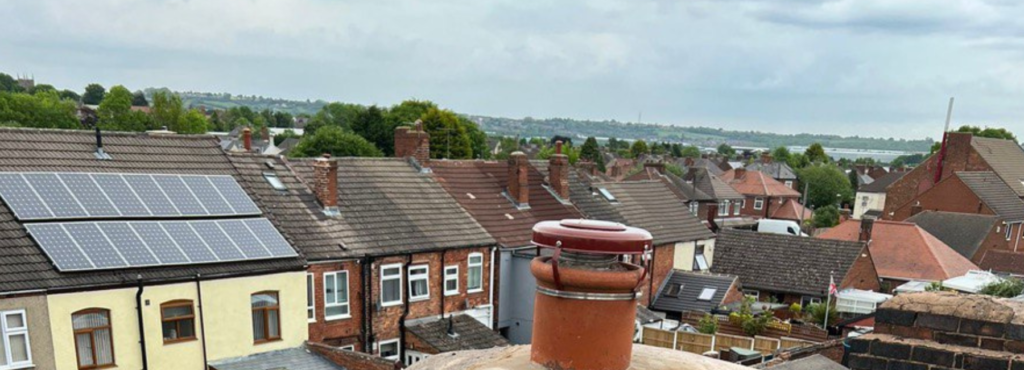Noticed a strange brown patch spreading across your ceiling? Before you reach for the paintbrush, it’s worth investigating the cause. Ceiling stains are more than just unsightly—they’re often a symptom of deeper roof problems. At Market Harborough Roofing Repairs, we’ve seen time and again how minor leaks turn into major issues when left unchecked.
This article will uncover the five most common hidden roof issues behind ceiling stains and explain why aaddressing them early can save your home from more serious damage.
1. Compromised Roof Flashing
Flashing refers to the thin metal sheets installed around roof edges, chimneys, and junctions where different parts of your roof meet. It’s designed to direct water away from vulnerable areas. But if flashing becomes cracked, loose, or corroded over time, water can seep into the structure underneath.
How it causes ceiling stains:
When water sneaks past the flashing, it can drip slowly through the roofing materials and insulation, eventually reaching your ceiling. Often, these leaks are small enough to go unnoticed until a noticeable patch appears indoors.
Signs to look for:
- Discolouration around chimneys or roof edges
- Ceiling stains directly below chimneys or skylights
- Mould growth near corners
2. Damaged Roof Tiles or Slates
Cracked, missing, or dislodged tiles are one of the most common culprits behind roof leaks. Especially during the windy or frosty months we see here in Leicestershire, your tiles can shift or break, leaving the underlay exposed.
How it causes ceiling stains:
Even a single damaged tile can allow water to get into the roof cavity. From there, it travels along rafters or joists before dripping into your ceiling.
Warning signs:
- Debris in your gutters
- Watermarks forming after heavy rain
- A damp, musty smell in the loft
3. Blocked or Leaking Gutters
Gutters are meant to channel rainwater away from your home. But when they become blocked with leaves, moss, or debris, they overflow—often straight into the fascia and roof structure.
How it causes ceiling stains:
Overflowing gutters can saturate the edges of your roof, especially if the water begins seeping into the loft area. The longer this continues, the more water seeps into the internal structure of your home, ultimately appearing as a dark mark on your ceiling.
Key indicators:
- Overflowing water during rainfall
- Mould near the top of internal walls
- Damp patches that grow after storms
4. Poor Roof Ventilation or Condensation
Roof leaks aren’t always caused by external damage. In some cases, poor ventilation or high humidity levels in the loft can lead to internal condensation, especially during colder months.
How it causes ceiling stains:
Warm, moist air from inside the house rises and becomes trapped in the loft. Without proper airflow, this moisture condenses on cooler surfaces, including the underside of the roof. Over time, the insulation becomes saturated, and damp begins to show on the ceiling.
Symptoms to check:
- Mould on loft timbers or insulation
- Stains appearing without recent rainfall
- A musty smell even on dry days
5. Valley Leaks or Structural Dips
Roof valleys are the channels formed where two sloping roof sections meet. They naturally carry more water runoff than flat areas, which means they are more prone to leaks if not installed or maintained correctly.
In some older properties, sagging or dips in the structure can also collect water rather than letting it drain efficiently.
Why this is problematic:
Pooling water increases pressure on the materials and eventually finds its way through even the smallest of cracks. These types of leaks are harder to spot and are often misdiagnosed.
What to notice:
- Puddles forming in roof valleys
- Ceiling stains that appear after extended rainfall
- Water damage near sloped roof junctions
What Should You Do If You Spot a Ceiling Stain?
It might be tempting to just paint over it and hope for the best, but that’s never a good idea. Acting quickly is crucial. If you’re unsure where the problem lies, calling in a local roofing specialist (like us here in Market Harborough) is the best course of action.
We’ll identify the cause, whether it’s external damage or internal moisture build-up, and offer a tailored solution to prevent the problem from returning.
Why Timely Repair Matters
A simple stain could be the sign of:
- Hidden rot in the roof structure
- Damp insulation, reducing your home’s energy efficiency
- Increased risk of mould growth
- Long-term damage to ceilings, plaster, and even electrics
Fixing these issues early can prevent more costly repairs in the future and protect the health of your household.
Conclusion
Ceiling stains aren’t just cosmetic—they’re a red flag. Behind that discoloured patch could be anything from missing tiles to blocked gutters or trapped moisture in your loft. The sooner you uncover the cause, the better.
At Market Harborough Roofing Repairs, we specialise in diagnosing and resolving hidden roof issues before they become disasters. Whether it’s a quiet leak or a more complex structural concern, our team offers the expert attention your home needs.
Spotted a stain? Don’t ignore it—reach out to us today for peace of mind and a dry, damage-free ceiling.
Call us on: 01858 457 198
Click here to find out more about Market Harborough Roofing Repairs
Click here to complete our contact form and see how we can help with your roofing needs.

